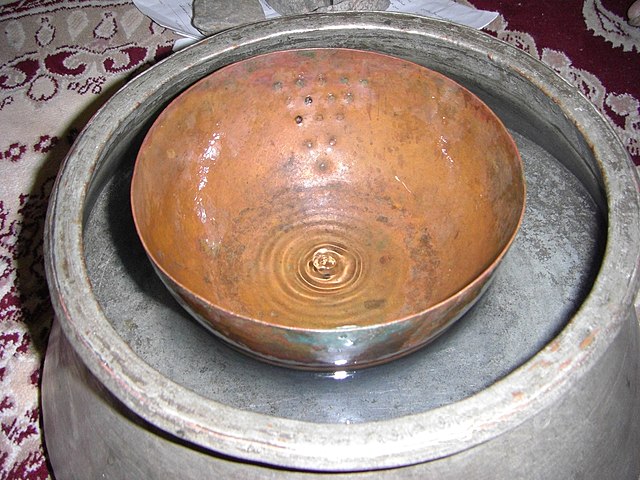計時工具的歷史
来自维基百科,自由的百科全书
千百年來,人類利用各種裝置來計時和報時。目前正在使用的六十進制時間系統,大約可以追溯至公元前2000年的蘇美爾。古埃及把一天分為二個部份,每一部份再分為12個小時,並使用大型方尖碑追蹤太陽的移動。他們還發明了水鐘(water clocks)。Precinct of Amun-Re 很可能是最初使用水鐘的地方,後來在埃及以外的地方也有人使用水鐘;古希臘人就經常使用叫作clepsydrae的水鐘。約在同一時間,相信商朝已使用洩水型水鐘──漏壺;而漏壺可能早在公元前2000年,從美索不達米亞傳入。其他古代計時器包括有蠟燭鐘──在中國、日本、英格蘭,和伊拉克使用;日晷──在印度和西藏,以及歐洲一些地區廣泛使用;此外,還有沙漏,運作原理和水鐘一樣。
此條目翻譯品質不佳。 |

最早期的計時工具日晷依靠太陽的陰影來報時,所以它們在多雲的天氣或夜間,沒有用處;而且如果「晷針」跟地球的軸心不一致,這些計時工具要依季節的變化,而重新校準。
第一個使用擒縱器(escapement)的鐘,於八世紀在中國出現[1]。11世紀,穆斯林工程師發明以重量驅動(weight-driven)的鐘。14世紀初,歐洲發明機械鐘。直到20世紀,機械鐘都是標準計時裝置。在20世紀,發明了石英振盪器,然後是原子鐘。石英振盪器最初只在實驗室使用,可是由於它容易生產而且準確,所以後來用在手錶上。原子鐘比所有計時裝置都準確,所以可以用於校準其他鐘錶;並且用來計算原子時和協調世界時。
早期的計時工具
許多古老的文明會觀察天體──通常是太陽和月亮,以確定時間、日期和季節[2][3]。現今在西方社會通用的六十進制時間系統,可追溯至約四千年前的美索不達米亞和古埃及 [2][4][5];後來,中美洲地區開發類似的系統[6]。
第一個日曆,可能在冰河時代末期,由狩獵收集者創造。他們利用如樹枝和骨頭等工具,記錄月相和季節[3]。 世界各地──特別是在史前時期的歐洲──都有石陣,例如英格蘭的巨石陣。石陣相信是用來預測晝夜平分點(equinoxes)或至點(亦稱二至點;solstices)等的時間[7][3]。那些巨石文明(Megalith)沒有留下歷史紀錄;因此,現代對他們的日曆或計時方法,所知甚少[8]。


日影鐘是第一個能夠量度小時的裝置[9]。已知道最古老的日影鐘來自埃及,用綠片岩製造。古埃及約在公元前3500年建造的方尖碑,也是最早的日影鐘之一[10][3]。
埃及的日影鐘把白天分為十個部分,另外加上4個「微亮小時」── 早上 2個、傍晚 2個。有一種日影鐘由一枝長桿和高架橫桿組成,長竿上有5個不相等的記號,橫桿的陰影會投射到記號之上。橫桿在早上指向東方,在正午會指向西方。方尖碑的運作方式差不多:陰影投射到圍繞它的記號上,埃及人從而可以計算時間。方尖碑可以指出上午或下午、夏至或冬至[3][11]。
現在己知最古老的水鐘 ,在法老阿蒙霍特普一世(公元前1525年至1504年)的墓中發現,這顯示古埃及最先使用水鐘[11][12][13]。另一方面,相信沙漏也是由古埃及人發明。此外,埃及自公元前600年,開始使用叫作merkhet的鉛垂線在晚間量度時間。這工具的鉛垂線跟勾陳一(北極星)一致,形成南北子午圈。當特定的星宿橫過線時,就能準確報時[11][14]。
柏拉圖把水鐘(漏壺)引進古希臘之後,水鐘成為古希臘廣泛使用的計時工具。柏拉圖也發明了一種以水鐘為基礎的鬧鐘[15][16]。希臘人和新巴比倫王國保存計時記錄,作為組成天體觀察的重要部分。漏壺也用在希臘法庭,和後來的羅馬法庭上。
雖然水鐘比日影鐘更好用──水鐘在室內、夜間或天空多雲的日子都可以使用;不過它們並不準確。因此,希臘人尋求方法改善他們的水鐘[17]。到了公元前325年,水鐘的準確度大為改善,雖然仍然及不上日影鐘。這時的鐘有鐘面,其上有時針,令人更容易讀準時間。水鐘較常見的問題是水壓:當容器注滿水時,增加的水壓令水流更迅速。在公元前100年,希臘和羅馬的鐘錶專家,開始解決這個問題;其後的幾個世紀,在這一方面得到持續改善。為了抵消高水壓增加的水流量做成的影響,裝水的容器造成圓錐形狀,上濶下窄。於是雖然水平面下降的距離相等,但當容器水滿的時候,流出的水要比水半滿的時候多。然而,還是有些問題沒有得到解決:如溫度的影響。天氣寒冷的時候,水流比較緩慢,甚至可能凍結[18]。
雖然希臘人和羅馬人大大改進水鐘的技術,他們仍然繼續使用影子鐘錶。據說數學家和天文學家比提尼亞的狄奧多,發明了全球通用的日晷。這個日晷在地球上任何地方都能準確報時,不過現代對它所知甚少[19]。羅馬人在奧古斯都大帝統治期間,建造有史以來最大的日晷──奧古斯都日晷(Solarium Augusti)。其晷針是從赫利奧波利斯(Heliopolis)而來的方尖碑[20]。
李約瑟推測水鐘──漏壺可能從兩河流域傳入中國,時間可能早達公元前二世紀的商代,最遲不會晚於公元前一世紀。由漢代(公元前202)開始,泄水型漏壺逐步被受水型漏壺取代,其特色是浮在受水壺水面上的漏箭,隨水面上升指示時間。
蠟燭鐘在何處及何時首次使用己不可考。不過,最早提到蠟燭鐘的,是一首寫於520年的中國詩。詩中說,燃燒的蠟燭是夜間量度時間的方法。直到10世紀初,日本一直使用類似的蠟燭鐘[21]。
遠東地區除了使用水鐘、機械鐘和蠟燭鐘外,也會使用香鐘計時[22]。中國大約在六世紀首先使用香鐘。在日本的正倉院,仍保存了一個香鐘[23],不過在其上的文字不是漢文,而是梵文[24]。由於佛教經常使用梵文,因此愛德華.沙菲爾推測香鐘在佛教儀式中使用,而且是由印度人發明[24]。香鐘跟蠟燭鐘很相似,不過香燒均勻而且無火焰,因此在室內使用時,比蠟燭鐘更準確和更安全[25]。
第一使用擒縱器的水鐘,由密宗僧人兼數學家一行和政府官梁令瓚建於長安[26][27] 這個擒縱器水鐘是個天文數儀器。一行的擒縱器鐘仍然是一個水鐘,因此會受溫度變化的影響。在976年,張思訓解決了這個問題。他用汞(水銀)取代水,汞在溫度下降到攝氏零下39度(華氏零下38度)時,仍然是液體。
元祐元年(1086年)蘇頌檢驗太史局的渾儀時,決心要將渾儀、渾象和報時裝置結合。蘇頌拜訪吏部守當官韓公廉,取得張衡、張思訓的「儀器法式大綱」。元祐三年(1088年)開始動工,元祐七年(1092年)「水運儀象台」竣工。
水運儀象台是一個類似於天文臺,高約12米,寬7米,上下分三層;上層是渾天儀(天體測量之用),中層是渾象儀(天體運行演示),下層是司辰(自動報時器),全程用水力推動,可精確報時,李約瑟指這是歐洲天文鐘的直接祖先。蘇頌於紹聖初年著《新儀像法要》一書,詳述水運儀象台的整體功能、零件150多種,60多幅插圖。
水運儀象台原件在靖康之禍(1127年)時,金兵將水運儀象台掠往燕京(北京)置於司天台,在金朝貞祐二年(1214年)因不便運輸被丟棄,而南宋時蘇攜保存的手稿因無人理解其中方法而無人能仿造。
近代計時工具


機械鐘由僧人一行和官員梁令瓚發明。至元明之時,計時器擺脫了天文儀器的結構形式,得到了突破性的新發展。元初郭守敬、明初詹希元創製了「大明燈漏」與「五輪沙漏」,採用機械結構,並增添盤、針來指示時間,其機械的先進性便明顯地顯示出來,時間性益見準確。
到14世紀,西方國家廣泛使用機械鐘。在十六世紀,奧斯曼帝國的科學家達茲·艾-丁(Taqi al-Din)發明機械鬧鐘[28]。
1583年,意大利人伽利略建立了著名的等時性理論,也就是鐘擺的理論基礎。1656年,荷蘭的科學家克里斯蒂安·惠更斯應用伽利略的理論,設計了鐘擺。第二年,在他的指導下,年輕鐘匠哥士達(S. Coster)成功製造第一個擺鐘。1675年,他又用遊絲取代了原始的鐘擺,這樣就形成了以發條為動力、以遊絲為調速機構,但擺鐘外形較大,不方便攜帶
18世紀期間發明了各種各樣的擒縱結構,為袋錶(或稱懷錶)的發展奠定了基礎。英國人喬治·葛咸(George Graham)在1726年完善工字輪擒縱結構;它和之前發明的垂直放置的機軸擒縱結構不同,所以使得袋錶機芯相對變薄。另外,1757年左右,英國人湯馬士·穆治(Thomas Mudge)發明了叉式擒縱結構,進一步提高了袋錶計時的精確度。這期間一直到19世紀,產生了大批鐘錶生產廠家,為袋錶的發展做出了貢獻。
1904年,飛行員阿爾拔圖·桑托斯-杜蒙特要求他的朋友,法國製錶匠路易士·卡地亞(Louis Cartier),設計一個他可以在飛行時使用的錶[29]。其實在1868年,百達翡麗已經發明了手錶,不過當時這種女士的手鐲錶,只當作首飾。卡地亞創造了桑托斯(Santos)手錶,第一隻為男士設計而且實用的手錶[30]。
1921年,華持·加廸(Walter G. Cady)製造第一個石英晶體諧振器。沃倫·馬利遜(Warren Marrison J. W. Horton)和JW.霍頓(J. W. Horton)於1927年,在加拿大的貝爾實驗室製造首個石英鐘[31][32]。之後幾十年,因為由真空管組成的石英鐘笨重,它只能設置於實驗室中。
1967年瑞士人發表第一款石英錶,1969年,精工製作了世界上第一個商業化生產的石英手錶──雅士圖(Astron)[33]。它的準確性和低生產成本,石英鐘錶受歡迎。
原子鐘比所有計時裝置都準確,數萬年才會誤差幾秒鐘,所以可以用於校準其他鐘錶[34]。第一個原子鐘於1949年發明,現陳列於史密森尼學會。美國國家標準局(又稱國家標準技術研究所)的銫原子鐘,每年的誤差只有300億分之一秒。
註釋
參考
廷伸閱讀
相關條目
外部連結
Wikiwand - on
Seamless Wikipedia browsing. On steroids.
